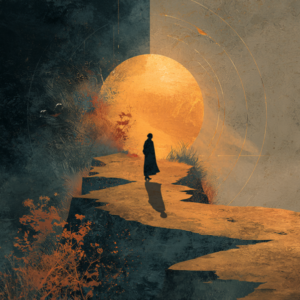On the path of personal and spiritual growth, there are times when what we call "awakening awareness" confronts us with aspects of ourselves that we would rather avoid. As we open to a greater awareness of our inner and outer reality, not only do states of clarity, peace and connection emerge, but also shadows that have long been waiting to be seen.
These moments can feel like setbacks or even a "crisis": confused thoughts, patterns of severe self-criticism or intense emotions such as fear, guilt or shame. However, such experiences are not an obstacle on the way, but an essential part of the journey.
The role of the shadow in the consciousness process
The shadow, a concept developed by Carl Jung, represents those aspects of our personality that we have repressed or denied because they do not fit with our self-image or with what we believe the world expects of us. These parts do not disappear, but remain in the unconscious, affecting our choices and our relationships in subtle but powerful ways.
When we begin a process of mindfulness, it is like turning on a light in a dark room. The light allows us to see what was always there, but which we had not noticed. What appears may be shocking or unpleasant: insecurities, deep fears, resentments or even limiting beliefs that we had accepted as truth. But this discovery also gives us the opportunity to bring compassion, understanding and transformation to these areas.
Confusing and harmful thoughts: messengers of the soul
When confusing or harmful thoughts arise, it is important not to identify completely with them. These thoughts do not define who we are; they are expressions of past hurts or learnings that need to be addressed. Instead of rejecting or fighting them, we can embrace them as messengers: What is this thought telling me about my fears, my wounds or my unmet needs?
The key is to observe without judgement. For example, if a thought arises such as "I am not enough", we might ask ourselves:
- When did I start to feel this way?
- What events or relationships might have seeded this belief?
- What do I need to start feeling enough now?
The simple act of observing with curiosity can diminish the power these thoughts have over us.
Darkness as an opportunity for healing
While facing the darkness can be challenging, it is also an invitation to heal. These moments allow us to:
- Recognising hidden woundsIntense emotions often point to wounds that need attention. For example, a sense of abandonment may go back to an unprocessed childhood experience.
- Releasing the repressedBy giving space for repressed emotions or thoughts to express themselves, we allow them to come out into the open and stop controlling us from the shadows.
- Building emotional resilienceLearning to be with our shadows strengthens us, as it shows us that we can go through the pain and emerge more whole.
Tools for navigating the shadows
- Meditation and conscious breathingThese practices help us to anchor ourselves in the present moment and observe our thoughts and emotions without being swept away by them.
- Therapeutic writingPutting into words what we feel can offer clarity and release emotional burdens.
- Professional accompanimentTherapists, coaches or spiritual guides can help us to explore our shadows safely and deeply.
- Connection with natureBeing in natural surroundings reminds us of our connection to something bigger and brings us calm.
Embracing our wholeness
The process of awakening consciousness is not about eliminating darkness, but about integrating it. We are whole beings, with light and shadow, and by accepting both parts, we come closer to our truest essence. In the words of Rumi: "The wound is the place where the light enters you".
Every confused thought, every intense emotion, is an opportunity to grow, to love ourselves more deeply and to remember that even in the darkness, we are always moving towards the light.
Much love to you and your process
Carlos



